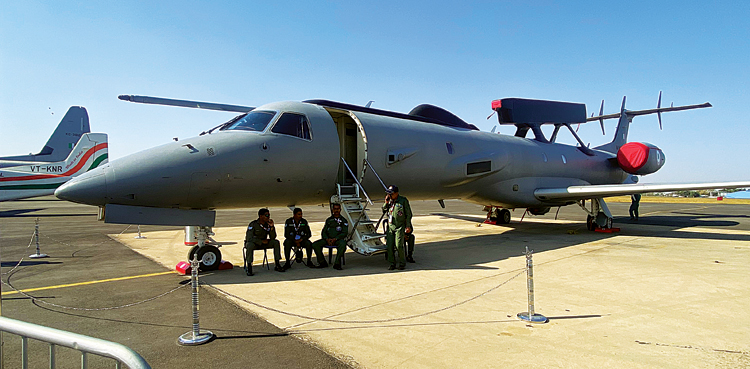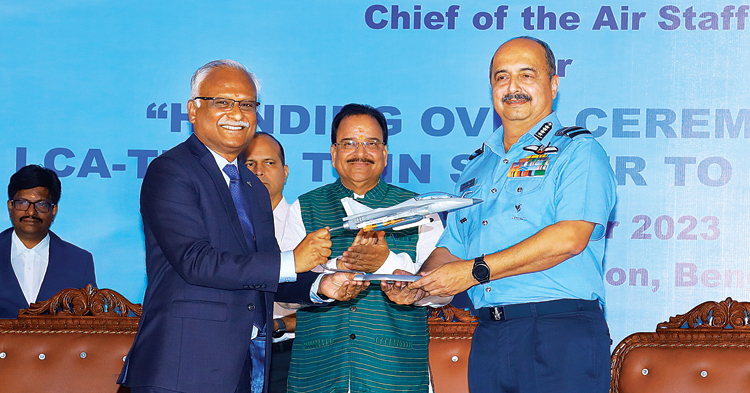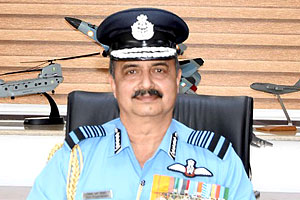INDIAN ARMED FORCES CHIEFS ON OUR RELENTLESS AND FOCUSED PUBLISHING EFFORTS

The insightful articles, inspiring narrations and analytical perspectives presented by the Editorial Team, establish an alluring connect with the reader. My compliments and best wishes to SP Guide Publications.

"Over the past 60 years, the growth of SP Guide Publications has mirrored the rising stature of Indian Navy. Its well-researched and informative magazines on Defence and Aerospace sector have served to shape an educated opinion of our military personnel, policy makers and the public alike. I wish SP's Publication team continued success, fair winds and following seas in all future endeavour!"

Since, its inception in 1964, SP Guide Publications has consistently demonstrated commitment to high-quality journalism in the aerospace and defence sectors, earning a well-deserved reputation as Asia's largest media house in this domain. I wish SP Guide Publications continued success in its pursuit of excellence.
- The layered Air Defence systems that worked superbly, the key element of Operation Sindoor
- Operation Sindoor | Day 2 DGMOs Briefing
- Operation Sindoor: Resolute yet Restrained
- India's Operation Sindoor Sends a Clear Message to Terror and the World – ‘ZERO TOLERANCE’
- Japan and India set forth a defence cooperation consultancy framework, talks on tank and jet engines
EXCLUSIVE
Quest for Global Outreach
On the occasion of the 91st IAF Day, Jayant Baranwal, Editor-in-Chief, SP’s Aviation spoke extensively to Air Chief Marshal V.R. Chaudhari, Chief of the Air Staff, on a range of subjects concerning the Indian Air Force

SP’s Aviation (SP’s): Heartiest Congratulations to you on the 91st anniversary of the Indian Air Force. As the Chief of the Air Staff, how do you perceive this great-long journey of our Air Force since its inception?
Chief of the Air Staff (CAS): From its modest beginning with four Westland Wapiti aircraft in 1932, the IAF has grown by leaps and bounds to become the fourth largest Air Force in the world. Since its inception, IAF has emerged as a crucial instrument of military power to protect the sovereignty and territorial integrity of our country. From its baptism by fire in 1947-48 to executing a well calibrated punitive strike in 2019, it is a saga, the entire country is proud of.
IAF is equally proud to be at the forefront in nation building. Be it evacuation of Indian diaspora from conflict zones outside the country or timely aid to civil power in HADR operations, IAF has always taken the lead. Evacuation of Indians from Sudan as part of Operation Kaveri, is one such unique achievement of the IAF, which makes me proud of my dedicated air warriors and asserts IAF’s dedication to the nation.
The theme for this year’s Air Force Day is “Airpower beyond Boundaries”. In our quest for global outreach, we carried out eight exercises this year with various Friendly Foreign Countries (FFCs) across the globe. In addition, we also conducted six exercises in India and more are in the pipeline.
SP’s: There is a saying that never underestimate your enemy who may otherwise appear to be smaller, on the face of it. Could you kindly elaborate on the key factors?
CAS: Countries, irrespective of size, economy or competence, in the quest for securing their national interests would take all possible steps to enhance their military capability. As military professionals, we constantly evaluate the geopolitical situation and assess the adversary’s military potential.
“Since its inception, IAF has emerged as a crucial instrument of military power to protect the sovereignty and territorial integrity of our country.”
—Air Chief Marshal V.R. Chaudhari, Chief of the Air Staff
Given the generally volatile and unpredictable situation in our neighbourhood, our forces need to be vigilant and proactive. Therefore, the key factors to prepare against any threat, big or small, is to have the capability to monitor the adversary continuously through persistent ISR, secure communication, efficient command and control systems and shorter response times. Another important factor is capability development wherein we are in the process of shifting from ‘threat based and demanded’ to ‘capability demanded’ force requirements. This approach permits us to build our capability to counter the adversary across the spectrum of conflict rather than aiming to counter only a specific threat. We are working on each of these critical factors and are prepared to address any threat posed by our adversaries.
SP’s: What is the most sought-after capability you would like to see the Indian Air Force must inherit without any delays?
CAS: The evolving character of warfare has placed enormous emphasis on multi domain operations in modern war fighting. Therefore, it is essential that we must be able to “see first and see the farthest, reach first and reach the fastest, and hit first and hit the hardest.” Battle space transparency, flow of information, and multi-domain solutions are key to success in future wars. Hence, without referring to any particular ability to imbibe, we should seek to enhance existing capabilities in quality and quantity to match the threat. These transformations have already been set into motion and are enabling the IAF to be future ready.
SP’s: Chandrayaan-3 has been a remarkable success story. We now have our rover on Moon since August 23, 2023. The country is proud of this superachievement, thanks to relentless efforts of ISRO. How would you like to comment on this development? Can this achievement also contribute towards the potential space-based capabilities of our country?
CAS: Chandrayaan-3 has made India proud. We are cognisant that ISRO has built an ecosystem of space related development and manufacturing of niche technologies, thereby propelling absolute self-reliance in the space domain. Space is an invaluable asset and every milestone in this domain takes us further in our quest to enhance our space based capabilities. Space based applications like Positioning, Navigation & Timing (PNT), ISR and communication are critical for air operations and we can use the expertise and achievements of ISRO to further improve these capabilities. IAF sees the technologies used in the mission as an opportunity to develop proven spin off technologies which will find utility in air and space operations in the future.
SP’s: As we continue working towards the goal of self-reliance in aerospace and defence industrial capabilities, how do you view the progress of research & development in our country? Do you think we are doing enough in R&D which is one of the most crucial factors towards achieving the self-reliance and making our country Atmanirbhar?
CAS: The progress of R&D in defence industrial capabilities and especially in aerospace domain has been encouraging. While the DPSUs and bigger domestic players are actively engaged in developing high end systems, it is heartening to see the progress made by startups and MSMEs in the aerospace domain. Due to India’s sustained efforts in “thinking out of the box”, we are ranked as the world’s sixth most ‘Innovative’ Country as per GE’s annual Global Innovation Barometer. IAF is fully committed towards the Nation’s vision of achieving Atmanirbharta and we have charted a focussed approach for achieving it. Initiatives through in-house R&D, iDEX and MAKE etc are helping us in our pursuit to acquire niche technologies.

Impetus towards self-reliance and strategic autonomy is something which has happened in a big way in the last one decade. While I am aware that a lot is being done, I feel that much more needs to be done. Recently the National Research Foundation has been instituted which will have dedicated funds for R&D. The private sector is also slowly stepping up its own R&D. This Government-User-Private partnership is a crucial step being executed seamlessly and has brought in selfreliance in certain critical areas of defence production.
SP’s: Nowadays the world is abuzz about the sixth generation fighter programmes, would you give us your perspective on our stand on this front? Where our country stands as far as such level of capabilities are concerned?
CAS: Development of future technologies is an ongoing process. R&D followed by production of a modern fighter is a very long process taking many years. We have successfully developed Light Combat Aircraft (LCA) Mk1 in-house and the LCA Mk1A is already flying. Development of LCA Mk2 and AMCA will herald us into the fifth generation technology regime. These programmes will serve as stepping stones towards development of sixth generation fighter aircraft.
SP’s: Kindly give us an update on the current status of: Fighter Squadrons, Force-Multipliers, Weapons and Armament, Air Defence, Transport Helicopters.
CAS: IAF currently has 31 fighter squadrons and will be inducting 83 LCA Mk1A from 2024 onwards. We are also processing a case for additional LCA Mk1A. Going by the envisaged timelines for induction of the LCA Mk2 and AMCA, the IAF is also pursuing the case for induction of 114 MRFA to bridge the gap of depleting squadron strength and to have adequate numbers of 4.5 gen aircraft.
As far as force multipliers are concerned, IAF is in the process of inducting six more Embraer based AEW&C and additional six Airbus 321 based AEW&C Mk-II with enhanced capabilities to strengthen our operational capability.
“Another important factor is capability development wherein we are in the process of shifting from ‘threat based and demanded’ to ‘capability demanded’ force requirements”
We are actively pursuing the case for induction of additional Flight Refuelling Aircraft (FRAs).
IAF has taken a giant leap towards modernisation of our Air Defence and conduct of Air Defence operations in a network centric environment. Akash, Medium Range Surface to Air Missiles (MRSAM), indigenous development of Long Range Surface to Air Missiles (LRSAM), High Power Radars (HPR), Medium Power Radars (MPR), Low Level Light Weight Radars (LLLWR), Low Level Transportable Radars (LLTR), Mountain radars are few examples. We have revamped our control and reporting structure with operationalisation of multiple Networked Tactical Nodes (NTN) by integrating various sensors that includes our airborne Air Defence (AD) platforms, radars and Surface to Air Guided Weapon (SAGW) systems.
Our transport fleet is a modern, flexible and credible fleet with a varied mix of aircraft. From strategic airlift to tactical airlift and from HADR to operations from Advance Landing Grounds (ALGs), our transport fleet is fully capable of taking on any challenge. With the recent induction the C295 aircraft, IAF’s transport fleet size and prowess has received a fillip.

The helicopter fleet is undergoing a major modernisation programme. Induction of Light Combat Helicopter (LCH), Advanced Light Helicopter – Weapon Systems Integrated (ALH WSI), and planned induction of Indian Multi Role Helicopter (IMRH) will bolster our helicopter fleet. Nine LCHs Limited Series Production (LSP) aircraft have been handed over to the IAF. The tenth helicopter is planned to be delivered in FY 23-24. Further procurement of LCH Series Production (SP) helicopters is under progress. The procurement of 6 Light Utility Helicopter (LUH) Mk-I is also under progress, with IA as the lead service. As far as the IMRH is concerned, the design, development and procurement of IMRH by HAL is being progressed. HAL had carried out Preliminary Design Studies of IMRH in 10-15 Tonne class considering the requirement of Indian Military Services and has arrived at a Preliminary Configuration for basic IMRH platform on the basis of Operational Requirements (ORs) given by IAF. The HAL proposal for the same is under scrutiny by IAF and Indian Navy (IN).
SP’s: Kindly share some updates on the key welfare schemes aimed to offer not only complete care to the human resource but also to keep them fully rejuvenated.
CAS: IAF is fully committed towards ensuring the well-being of our people and their families. Financial assistance and support to personnel and their families with physical disabilities and special needs is provided by IAF through Indian Air Force Benevolent Association (IAFBA) and Air Force Wives Welfare Association (AFWWA). IAF is also providing various welfare schemes like scholarships, vocational training, grants and subsidy to our Veer Naris for acquiring dwelling units.
IAF has given special impetus on resettlement training since it improves post retirement employability in various sectors. Pre-release courses from premier institutes like IIM and IIT are being offered to personnel for their second career.
“It is essential that we must be able to ‘see first and see the farthest, reach first and reach the fastest, and hit first and hit the hardest.’ Battle space transparency, flow of information, and multi-domain solutions are key to success in future wars.”
Induction of Agniveer has been a revolutionary change in the armed forces. MoU’s between IAF & Indira Gandhi National Open University (IGNOU) have been signed for academic enhancement and award of degree for aspirational Agniveervayu personnel.
HR planning and management has always been the focus area of the IAF to meet the aspirations of all personnel with regards to their promotions, postings and release.
SP’s: In the recently held IPACC Conference, US Army Chief said that India is perceived as a Regional Power. Can we ask you what all is needed be a Regional Power?
CAS: What he said is absolutely correct. The elements which are required to assert national power and influence can be summarised by the acronym DIME - Diplomatic prowess, Information, Military and Economic factors and these are all the pillars of design to be written as a regional power. We are on our way globally to be recognised as regional power.






